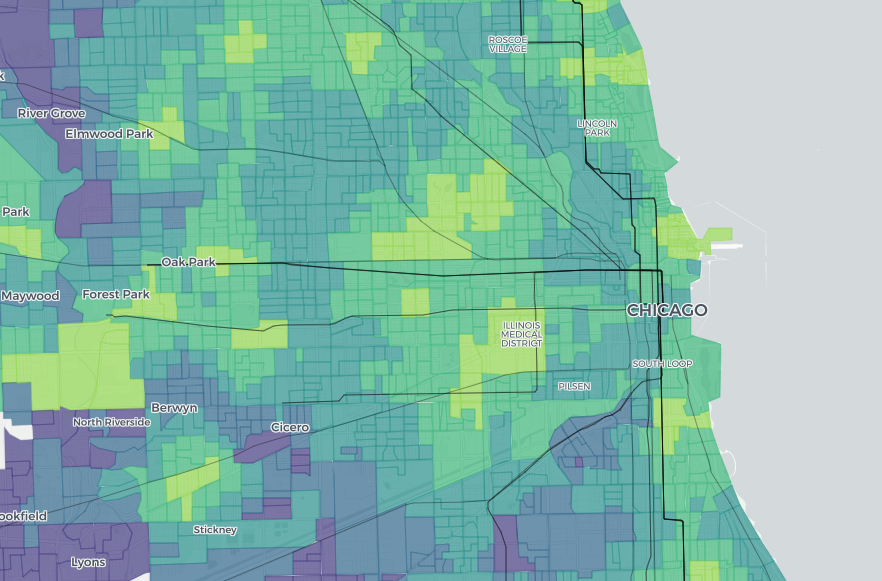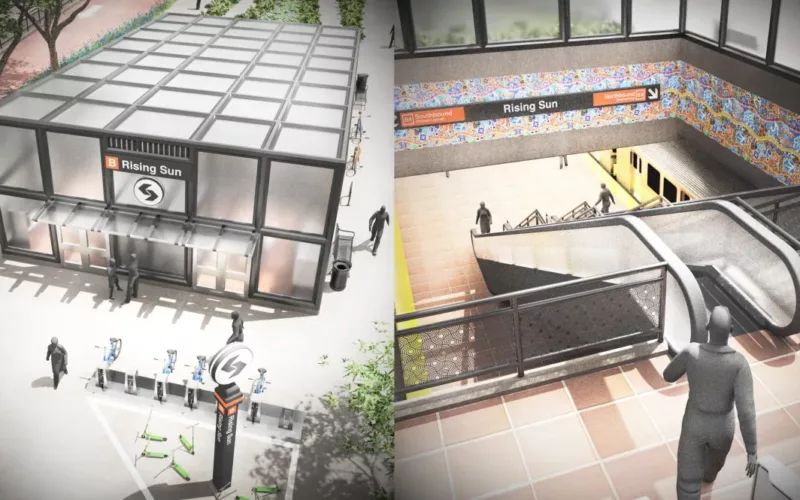
A map of transit access to hospitals in the Chicago region from the Transit Equity Dashboard.
The Civil Rights Act of 1964 offers bedrock protections against discrimination to all Americans. One section of the law, Title VI, bans discrimination on the basis of race, color, and national origin in programs receiving federal funding. This is the language that applies most directly to public transit.
While federal law can prevent some inequitable decisions, it has proven insufficient to secure equitable transit. That will always require local leadership, but stronger federal regulations can help. In November, the Federal Transit Administration asked the public for advice on what those regulations should look like.
The FTA implements Title VI through a set of rules and guidance known as the Title VI Circular. These rules–last updated in 2012–require transit agencies that receive federal funding to adopt specific policies aimed at avoiding discrimination. For example, the circular requires that agencies publish demographic information about their board and advisory committee members and address access for riders with limited English proficiency.
One of the most important ways the circular regulates transit agency activities is the requirement to conduct equity analyses before changing service or fares. These analyses aim to determine whether a proposed service or fare change would have a “disparate impact” on residents or riders of color. However, these analyses are narrow, easily gamed, and insufficient as a mechanism to secure equitable transit.
FTA periodically reviews agency policies to ensure compliance with Title VI, generally every three years. Members of the public can also challenge agency decisions by filing administrative complaints; in response, FTA can order policy changes or even withhold federal funding to agencies. However, these complaints are hard to win, and the main power of the circular comes through the standards it sets for transit agencies.
Today, these standards are weak, with little ability to secure equitable transit. So it’s encouraging to see that in its request for information from the public, FTA asks a series of questions that suggest it is open to major changes to the rules. A revitalized approach to Title VI could require agencies to measure equitable transit access, create new ways to hold agencies accountable for discriminatory policing, and help agencies implement inclusive public participation.
Comments will be accepted until January 3, and can be submitted here; comments should reference “docket number FTA-2021-0014.” Here is TransitCenter’s full submission to FTA. Below, we summarize four main points.
Measure access to destinations
FTA asks whether the service equity analysis should incorporate access to destinations, measures of transit’s ability to connect people with the destinations they value. We support FTA requiring such analysis, which can better convey the benefits of transit (and who enjoys those benefits). This type of analysis can be generated with data that is widely available to transit agencies, but would have to be implemented with substantial technical assistance provided to grant recipients.
As we described in July comments to the US Department of Transportation, TransitCenter’s Transit Equity Dashboard measures equitable transit access in the seven U.S. regions with the highest transit ridership. For example, in the D.C. region, the average white resident has access to nearly 100,000 more jobs than the average Black resident within 45 minutes using transit. Meanwhile, the median resident has access to 1.9 million jobs by car in 45 minutes, compared to 199,000 by transit. This suggests that public transit in the Washington region is both inadequate and inequitably distributed.
The dashboard also measures access to nonwork destinations, such as average travel time to nearby grocery stores. Which nonwork measures to use may be best for local policymakers and community members to decide, rather than being prescribed by FTA.
While access-to-opportunity analysis is a useful way to gauge proposed service changes, it is more important to require an access-to-opportunity analysis of an entire transit network every 1-3 years. Such analysis can be used to measure the equity of a region’s existing transit network and whether that network offers more equitable access over time. It can be the foundation of a new approach to measuring transit equity, one that demonstrates progress over time instead of analyzing static changes.
Scrutinize discriminatory “code of conduct” policies
FTA asks whether the Circular should address transit rider “code of conduct” policies–agency rules that regulate fare evasion, putting feet or bags on seats, playing music, eating and drinking, and other actions that agencies prohibit in order to provide a clean, pleasant environment.
While there are reasons to have such policies, on several transit systems, disparate enforcement of “code of conduct” rules has harmed low-income people and riders of color. Incorporating conduct policies into the Title VI Circular would create a new accountability mechanism. We support FTA developing a new analysis of rider conduct policies and their enforcement, and requiring agencies to conduct that analysis.
Strengthen guidance on public participation
Today, the Title VI Circular suggests a few best practices for public participation, like advertising meetings in non-English media and using a mix of meeting sizes and formats. FTA asks what other engagement practices it should include as guidance.
We suggest several, as recommended in Equity in Practice, the report we released with the Center for Neighborhood Technology in September. (Examples from the Twin Cities, Miami, Seattle, and Boston referenced below are case studies in that report.) FTA should recommend that agencies:
Engage directly with advocacy groups and community-based organizations in public participation campaigns. Recent experience in the Twin Cities and Miami shows how community-based organization-led outreach can effectively engage residents during a planning process.
Use “inclusive approaches” to maximize the participation of affected communities. For instance, King County Metro works with a “Mobility Board” of diverse community members to co-create service change proposals around new light-rail stations. Other recent examples: In Boston, the MBTA’s 37-member external working group provides input on its “Better Bus” policies; and in Miami, Transit Alliance used text campaigns to solicit rider feedback for Miami-Dade Transit’s bus network redesign.
Enact policies to compensate organizations and individuals who represent communities who contribute time to public participation campaigns. FTA could assist by identifying and addressing federal procurement rules that make this difficult for agencies.
LA Metro adopted a Community-Based Organization Partnership Strategy in June, which outlines how agency departments can consistently and equitably partner with community-based organizations that contribute professional services to the agency’s interactions with communities. Among the strategy’s recommendations is using a standard assessment to determine when compensating community groups for contributions to agency operations is warranted. LA Metro’s checklist considers if the contributions of community groups are aligned with the agency’s goals, are similar in scope to work of paid consultants, will produce a distinct deliverable, and represent a unique expertise or skillset that LA Metro needs.
Analyze qualitative data generated in public participation as part of required equity evaluations. Some aspects of how people experience transportation are difficult to evaluate with quantitative data alone. Examples include people’s perceptions of safety on public transit, or obstacles that keep people from traveling by public transit at all. Engagement with community members can create qualitative data sets that can supplement existing quantitative equity evaluations.
Service and fare analyses should include change over time and regional context
Fundamentally, the time period and geography of service and fare analyses limit the ability of the public to understand whether disparate impacts are occurring.
Most agencies perform service and fare change analyses that compare transit immediately before and immediately after the change. But communities can be hurt through disinvestment that occurs over longer time periods. FTA should explore supplementing the service and fare change analyses with additional analyses that are performed on longer time scales.
FTA should require analyses of the cumulative impact of all service changes that occur in a year, or longer periods such as 3 or 5 years. FTA could also require that agencies’ definitions of a major change account for cumulative change. For example, Los Angeles Metro defines a service change as major if it “increases or decreases the route miles and/or the revenue miles operated by 25% or more at one time or cumulatively in any period within 36 consecutive months since the last major service change.”
The service and fare analyses also disregard the regional nature of transit equity. Each agency measures the equity of a change against its own service area. However, the majority of transit riders in the U.S. live in regions with complex transit networks operated by multiple agencies. Within a region, the definition of a “major change” and “minority route” may differ by agency, even when agencies provide service in the same neighborhoods.
Whether or not a service change actually has disparate impact may depend on service changes implemented by other agencies. For example, if one agency opens a new light rail line, this context should be accounted for when analyzing the elimination of a parallel bus route operated by a different agency. FTA should develop guidance for how to account for disparate impact in the context of regional transit networks.
 On the Brink: Will WMATA’s Progress Be Erased by 2024?
On the Brink: Will WMATA’s Progress Be Erased by 2024?
The experience of being a WMATA rider has substantially improved over the last 18 months, thanks to changes the agency has made like adding off-peak service and simplifying fares. Things are about to get even better with the launch of all-door boarding later this fall, overnight bus service on some lines starting in December, and an ambitious plan to redesign the Metrobus network. But all of this could go away by July 1, 2024.
Read More To Achieve Justice and Climate Outcomes, Fund These Transit Capital Projects
To Achieve Justice and Climate Outcomes, Fund These Transit Capital Projects
Transit advocates, organizers, and riders are calling on local and state agencies along with the USDOT to advance projects designed to improve the mobility of Black and Brown individuals at a time when there is unprecedented funding and an equitable framework to transform transportation infrastructure, support the climate, and right historic injustices.
Read More